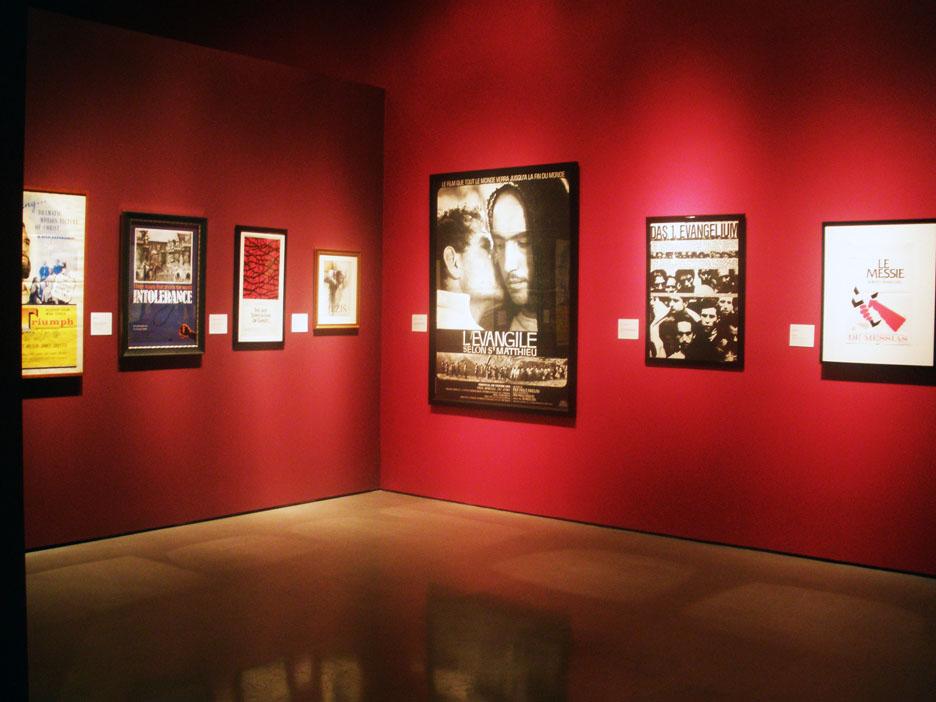Museum of Biblical Art Features Religious Film Ephemera
June 12, 2011

Published: February 26, 2009
Ducking into the Museum of Biblical Art (MoBIA) on a rainy afternoon, I felt enveloped by the warmth of the intimate gallery, painted a vibrant maroon and emblazoned with the vibrant colors of the movie posters hanging on the walls. This current exhibition, titled Reel Religion: A Century of the Bible and Film, features not only many film posters, but also some props, movie stills and other ephemera from various religiously-themed films. Wandering through the show, I admired the striking design of many posters and the sheer volume of items on view. Still, I found myself somewhat confused. Why have this exhibit now? The most recent films referenced were Mel Gibson’s “The Passion of the Christ” (2004) and Jean-Claude La Marre’s “Color of the Cross” (2006).
The exhibit is admirable for its array of one-sheet film posters from all over the globe, from the United States to Sweden to Japan. This variety is the show’s greatest strength, along with the tidbits of obscure information that accompany the memorabilia. For example, who would’ve known that the now-common, one-sheet film poster (the single, typically 27” x 41” poster you might see advertising a film at your local cinema) originated with a religious movie? The promotional poster for “The Passion Play of Ober-Ammergau,” released in the U.S. in 1898, was the first of its kind. It boasted an “actual scene” of Jesus’s crucifixion from the film and is the oldest movie poster in existence.
Various genres of Biblically-inspired cinema are represented, including the Passion Play and the life of Jesus, early Christian history and legend and the “sword and sandal epics,” such as “The Ten Commandments” (1956) and “Ben-Hur” (1959). For every genre, the eye-popping style of poster art works wonders. The sleek design, momentous action scenes portrayed and the lush color palette, typical of this genre of art, convey the epic quality of the films. Some of the most memorable posters include the scaled-down billboard for Cecil B. DeMille’s “King of Kings” (1927), a Japanese poster for “Jesus Christ, Superstar” (1973) and the abstracted crown of thorns that graces the poster for Martin Scorsese’s “The Last Temptation of Christ” (1988).
Other highlights include the chest plate worn by Yul Brynner in his role of Rameses in “The Ten Commandments,” designed by famous Hollywood costume designer Edith Head, and the cape worn by Charlton Heston in “Ben-Hur.” These objects actually lose very little of their Hollywood magic in real life, presented as they are in glass cases, surrounded by the dazzling posters. In some ways, you can’t help but feel as though you’re surrounded by the stuff of legend.
Despite all of this glitter, to some degree it feels like that’s the extent of the exhibit. Though it showcases some rare film memorabilia, there seems to be little reason for doing so at the present moment. There are no links to current or recent theatrical releases that are based on the Bible. The show would be strengthened significantly by such a connection, which would likely lure in more of the general public. As it stands, this show seems ideally suited to a more specialized set of individuals, such as film buffs, those interested in the relationship between Christianity and film and graphic design scholars or students. Perhaps more attention will be garnered by the Reel Religion Film Series planned for the spring, which might help draw people in and entice them to stay and examine some of the film-related items in the MoBIA galleries. Still, the other-worldly atmosphere that permeates the exhibit is akin to the reverence we might feel bathed in the shimmering glow of church candles—or even the silver screen.








